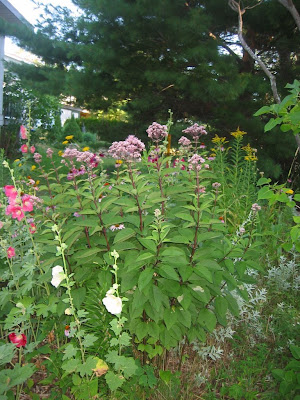
 Sunday, 8:15 AM. 60 degrees, wind WSW, calm. The channel is slightly wrinkled, the sky blue with some haze. The barometer predicts mostly sunny skies. It will be a warm late summer day.
Sunday, 8:15 AM. 60 degrees, wind WSW, calm. The channel is slightly wrinkled, the sky blue with some haze. The barometer predicts mostly sunny skies. It will be a warm late summer day.There are fall warblers in the yard now, flitting about, unidentifiable in the leaves (or out).
I picked another pint of wild blackberries from the few bushes in the front corner of the yard. They are plump and tasty after the rain. The closest I will get to identifying them is Rubus flagellatis, an appropriate species name. They demand their blood price for every pint picked. They are blackberries rather than black raspberries for two reasons; the running canes root at the tip, and the berries do not pull easily from their stems as do raspberries, but rather break off, stem included. They are a real bramble and worth your life trying to go through them with walking shorts on. Each berry gets an “ouch” or a cuss word as it is picked.
After church and lunch I will go out to the Town of Russell shooting range and toss myself some clay pigeons and see if I still have the eye and reflexes to maybe bring down a grouse, the season opening in two weeks.





























































